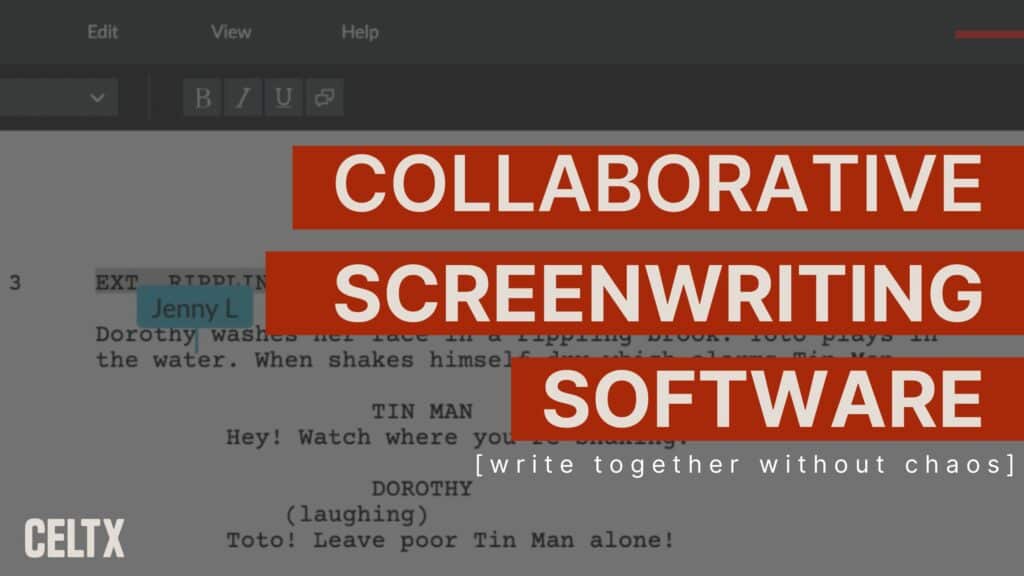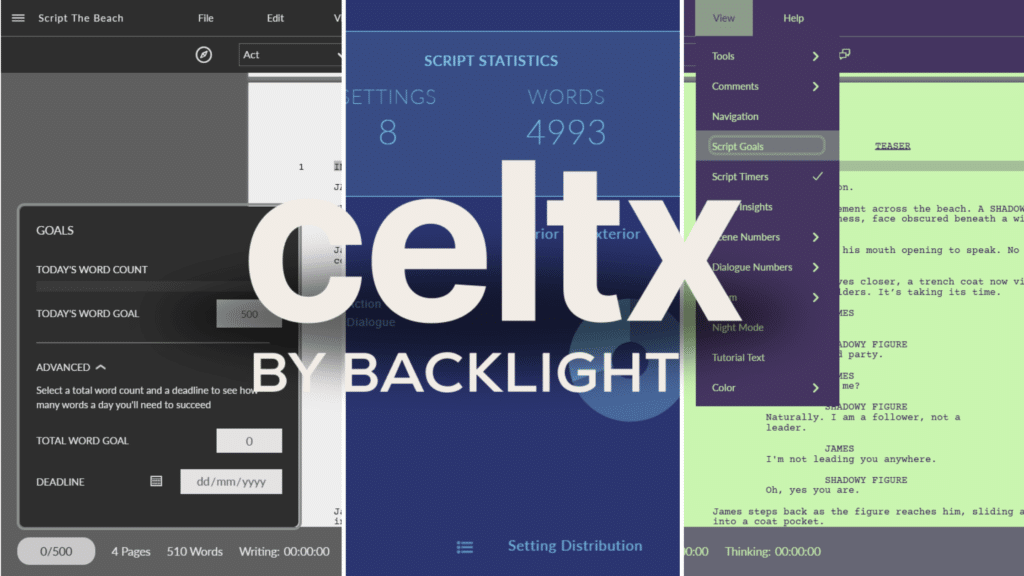
Writing a screenplay is challenging enough when it’s just you and your imagination. Add a co-writer, or a full writing team into the mix, and the process can feel less than a creative collaboration and more like a headache.
If you’ve ever tried to co-write a script using endless email attachments or a cluttered Google Doc, you already know the pain of mismatched drafts, overwritten scenes, misplaced notes, and the dreaded question: “Wait, which version are we working on?”
And so, enters collaborative screenwriting software. It’s become an essential tool for modern writers. It doesn’t just make co-writing possible, but makes it smoother, more efficient and even more enjoyable!
In today’s blog, we’ll break down what collaborative screenwriting really means, the frustration it solves, the key features you should look for, and how platforms like Celtx help teams write together without losing their scripts, or their sanity.
We’ll even throw in some of our best top tips to make sure your co-writing sessions are productive, and most importantly, fun.
Table of Contents
- What is Collaborative Screenwriting?
- Common Frustrations
- Features to Look for in Collaboration Software
- How Celtx Handles Collaboration
- Other Collaborative Screenwriting Software
- Best Practices for Co-Writing a Script Remotely
- FAQ
- Conclusion

What Is Collaborative Screenwriting?
Collaborative screenwriting is the process of writing a script with other people, usually in real-time or through shared access to the same project.
Unlike traditional ‘solo writing’, collaboration requires tools and workflows that allow multiple writers, editors, or producers to contribute without derailing the creative process. It sets off the production process on a good foot as a project goes into development.
So, practically, this might mean:
- Two writers brainstorming action lines and dialogue in real time.
- A director leaving comments directly in the script.
- A producer flagging budget concerns in the same document.
- A writing team splitting episodes or acts, then merging them into one coherent draft

Collaboration isn’t new. Many of the best screenplays in history were co-written.
But what is new is the ability to collaborate seamlessly across distances, time zones, and even devices.
With cloud-based software, writing partners no longer have to sit in the same room with stacks or paper or send floppy disks back and forth (yes, that really used to happen!)
The challenge now isn’t whether you can collaborate remotely. It’s how to do it without stumbling into version chaos or stepping on each other’s toes.
Common Frustrations
Anyone who’s tried to co-write a script either in a partnership or within a writers room, without the right tools knows it can quickly become a logistical nightmare. Here are some of the biggest frustrations collaborative software is designed to solve:
Version Hell
Perhaps the most notorious problem for co-writers is multiple drafts floating around with cryptic names like Final_Scirpt_v7_revised_REALLY_FINAL.docx.
One writer makes edits in an old draft, another starts working in a newer one, and suddenly no one knows which version is ‘official’.
Conflicting Edits
Two writers might edit the same scene at the same time. Without a system to merge or highlight changes, you end up with overwritten dialogue, missing lines, or creative conflicts.
Lost Notes
When you send and receive feedback via text messages, emails, or sticky notes, it’s easy to lose them. Worse, you may repeat the same conversations because no one remembers where the feedback was stored.

Formatting Fights
Screenwriting has strict formatting rules. If one writer is working in Word, another in Google Docs, and another in Final Draft, you spend more time reformatting then actually writing.
Creative Tension
Collaboration requires compromise, but without built in structure, discussions about dialogue, pacing, or character can spiral into endless debates rather than actionable changes.
Frustrations like these don’t just waste time. They sap creative energy, create friction between collaborators, and can even derail very promising projects.
Okay, so how can we avoid these sorts of frustrations? Well, using dedicated collaborative screenwriting software is a great start.
Features to Look for in Collaboration Software
Not all writing tools are built for screenwriters, and not all screenwriting tools are built for collaboration. If you’re choosing a platform for co-writing, here are the features you need to look out for:
Real-Time Collaboration
Like Google Docs, the ability for multiple people to type, edit, and view changes simultaneously is crucial. You shouldn’t have to wait for someone to ‘send the latest draft’.
Change Tracking
Every team needs a way to see who changed what and when. Track changes keeps everyone accountable and makes it easy to revert edits if needed.
Commenting and Feedback
Notes should live inside the script, not in a separate email thread. Inline comments and discussion threads allow for context-specific feedback that everyone can see.

Role-Based Permissions
Not everyone in your crew needs editing power. Good software lets you invite collaborators as editors, commenters, or viewers depending on their role in the project.
Automatic Version Control
The software should save and organize versions automatically, so you can always return to an earlier draft without digging through folders.
Industry-Standard Formatting
Even if you’re working solo, using the correct screenplay formatting is essential! Your software should handle screenplay formatting so you can focus on the story, not margins or indents.
Cloud Syncing and Accessibility
Your script should be accessible anywhere, anytime, whether you’re at your desk, on set, or brainstorming in a café.
This sounds great, but where can you find all these features in one place? Well, Celtx of course!
How Celtx Handles Collaboration
Celtx is one of the most popular screenwriting platforms. Designed from the ground up for teams, Celtx offers features that address the very problems we outlined above.

So, why should you choose Celtx? Here are five reasons why:
Invite Anyone
With Celtx, you can invite collaborators via email and control their permissions. This means you can have full co-writers, limited commenters, or even producers who just need to view progress. No messy file sharing also ensures everyone logs into the same project, and the right draft.
Comment Directly into the Script
Feedback doesn’t get lost in emails or online messages. Instead, comments are tied to specific lines of dialogue or scenes, so context is always clear. Writers can rely, resolve, or revisit notes at any time.
Find out more about commenting in Celtx here.
Track Changes and Revisions
With Celtx, you can automatically track edits and save versions, so you always know who made what change. Accidentally deleted a scene? No problem, you can roll back to an earlier draft with a single click.
Take a look for yourself:
Real-Time Writing
Multiple writers can work in the script simultaneously with everyone being able to view each other’s edits in real time. This makes brainstorming dialogue or pacing adjustments an absolute breeze.
Beyond the Script
Sounds too good to be true, doesn’t it? Well, Celtx isn’t just a writing app. We also added pre-production tools like storyboarding, shot lists, and budget planning, all of which can be collaboratively managed.
These features make our software suite especially useful for teams that want to move seamlessly from script to production.
Okay, so Celtx isn’t the only option available for collaborative writing. Several other platforms are work considering, each with its own approach to collaboration.
Still need convincing? Well check out this episode from our Celtx Academy, all about how our collaborative features work:
Other Collaborative Screenwriting Software
Let’s take a look at the five other options:
WriterDuet
Another cloud-based tool designed specifically for co-writing. WriterDuet offers unlimited real-time collaboration, inline comments, and detailed revision tracking.
It’s a popular choice especially among remote writing partners.
Final Draft
Long considered the industry standard, Final Draft now includes a collaboration mode that allows multiple writers to work on the same script simultaneously. Its widespread use in Hollywood makes it a safe choice for professional teams.

Arc Studio Pro
Known for its clean interface and intuitive outlining tools, Arc Studio Pro offers live collaboration that’s similar to Google Docs (so it could be the one for you if you’re a Word processor lover).
Fade In
A professional-grade, budget-friendly alternative to Final Draft, Fade In supports cloud syncing and real-time collaboration. It’s also compatible with multiple file formats.
Squibler
A new player in the market, Squibler combines collaborative writing with project management features. It’s great for teams who want both drafting and planning in one platform.
Best Practices for Co-Writing a Script Remotely
Even with the best software around, collaboration still requires thoughtful communication and management. Here are our top tips for co-writing remotely:
1. Define Roles Early
I know, once you’ve assembled your writing team, it can be tempting to dive straight in. But hold fire! First clarify who handles what. Will you alternate scenes? Will one writer handle dialogue, while another focuses on structure? Clear roles prevent duplicate work and hurt feelings.
2. Agree on Communication Channels
Decide how you’ll discuss ideas outside the script. Will you use Slack? Zoom? Weekly check in calls? Having one agreed-upon communication hub prevents scattered feedback.

3. Schedule Writing Sessions
If possible, schedule overlapping times to write together in real time. This not only keeps communication channels open but builds momentum and helps settle creative debates quickly.
4. Use Comments, Not Texts
Keep all script-related notes inside the script itself. That way, everyone has access to the same feedback in context.
5. Respect Creative Differences
Conflict is inevitable. Instead of debating endlessly, why not try the ‘two-version test’? Keep both versions of a scene, then re-read them later to decide which works better.
6. Keep Versions Organized
Even with automatic versioning within software, it’s good practice to label each milestone. Use clear titles such as “First Draft Complete” or “Producer Feedback Incorporated”.
7. Celebrate Progress
Co-writing isn’t just about finishing a script, but about enjoying the process together. Take time to celebrate when you finish an act, solve a tricky plot problem, or land a killer line of dialogue.
But most importantly, have fun with the process!
And talking of celebrations, if you need some inspiration, check out these successful collaborations of the alumni from the New York Film Academy.

FAQs
You can, but you’ll spend a lot of time manually formatting. Dedicated screenwriting software ensures your script meets industry standards automatically.
If you insist on using Google Docs to write your screenplay, here is our step-by-step guide.
Celtx allows multiple collaborators, and you can set different permission levels depending on roles.
That’s where real-time editing and built-in commenting shine. Even if you’re not online together, you can leave notes and updates for each other asynchronously.
Celtx offers both free and paid plans. Our free version gives you basic tools, while premium plans unlock advanced collaboration and production features.
Use comments, save alternate versions, and revisit decisions after a cool-down period. The best scripts often come from healthy debate. Communication is key!

Conclusion
Collaborative screenwriting doesn’t have to be a chaotic tug-of-war between creative visions. With the right tools and practices it can be a dynamic, exciting way to build stories together.
Instead of drowning in email attachments, battling over formatting, or losing track of edits, writers can now focus on what really matters: the story. Tools like Celtx make collaboration seamless, with real-time writing, comments, tracked changes, and production-ready workflows.
Whether you’re working with one trusted co-writer or a full team of creatives, the key is finding software that removes friction and keeps everyone aligned. Combine that with clear communication, role definition, and respect for each other’s contributions, and you’ll find that co-writing isn’t just manageable but inspiring.
In the end, collaboration is at the heart of filmmaking. Screenplays are written to be brought to life by dozens, or even hundreds, of people. Starting that collaborative spirit at the writing stage isn’t just practical. It’s the best way to ensure your story survives the journey from page to screen.
Ready to take your writing further, together? Click here to get started with Celtx
Up Next:

7 Celtx Features You’re Not Using (But Should Be)
Think you know Celtx? Chances are, you’re missing out on tools that could make your writing and production process even smoother. Learn about them in this article!
